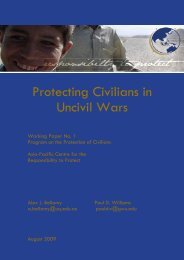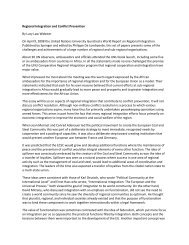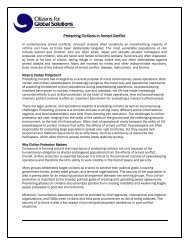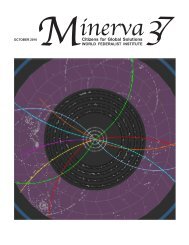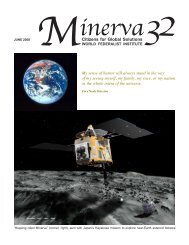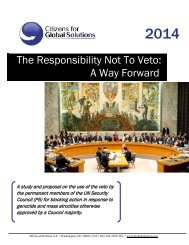Extreme InjuryElaine ScarrySeptember <strong>2011</strong>Elaine Scarry, Walter M. Cabot Professorof Aesthetics & the General Theoryof Value at Harvard University andauthor of The Body in Pain, among otherbooks, most recently has written Thinkingin an Emergency (the first volume inAmnesty International’s <strong>Global</strong> Ethicsseries) and Rule of Law, Misrule of Men.This essay first appeared in the September/October<strong>2011</strong> edition of the BostonReview. It is reprinted by permissionof the author.In a 2008 television interview, <strong>for</strong>mer Vice President Dick Cheney addressed complaintsabout the overreaching of the executive branch. In order to defend the Bushadministration, he might have argued that reports of presidential overreaching wereexaggerated. Instead he argued the opposite: the public, he suggested, has an insufficientappreciation of how truly vast that presidential power is. Accompanied aroundthe clock by a military aid carrying the nuclear football,[The president] could launch the kind of devastating attack the world hasnever seen. He doesn’t have to check with anybody. He doesn’t have to callthe Congress; he doesn’t have to check with the courts. He has that authoritybecause of the nature of the world we live in. It’s un<strong>for</strong>tunate, but I thinkwe’re perfectly appropriate to take the steps we have. 1Cheney makes the transition from the first three sentences to the fourth as though hisconclusion followed ef<strong>for</strong>tlessly from his premises: the president’s license to launchnuclear weapons (accurately described by Cheney, and true of every president livingin the nuclear age from Eisenhower to Obama) makes his otherwise illegal executiveactions — however “un<strong>for</strong>tunate” — “perfectly appropriate”.What Vice President Cheney seems to be saying is this: if you keep in mind the vastlevel of injury the president is permitted to inflict on the world, it will help you keepin perspective the lesser injuries he has actually inflicted: the 350 people allegedlytortured, the 83 times Abu Zubaydah was water boarded, the 183 times Khalid SheikhMohammed was water boarded, 2 the 3x6x7-foot cell (rat-infested and latrine-free) inwhich the wholly innocent Canadian citizen Maher Arar was kept <strong>for</strong> a year duringwhich time he was periodically beaten with a two inch–thick cable and threatened withbeing suspended upside down from a tire and subjected to electric shock. 3 Each timeyou think that the perpetrators of such acts should be prosecuted, replace that pictureof prosecution with a picture of what is always in the president’s field of vision: thenuclear football.Of course, neither picture should displace the other. Prosecuting the architects of UStorture is critical to restoring the rule of law, as I and countless others have arguedand continue to argue. But we should also, as Dick Cheney counsels, think about the40-pound titanium briefcase that accompanies the president (as well as, in one <strong>for</strong>mator another, the executive officers of other countries) and enables him to launch a nuclearstrike. Nuclear weapons need to be gotten rid of first and <strong>for</strong>emost <strong>for</strong> their ownsake and also <strong>for</strong> the “lesser” brutalities they license.Our nuclear weapons are, at every minute of the day and night, ready <strong>for</strong> use. Just asthe nuclear briefcase is within the president’s reach, so all other steps between theorder to launch and the launch itself are relentlessly in place. In his recent biographyWithout Hesitation, <strong>for</strong>mer Chairman of the Joint Chiefs of Staff Hugh Shelton describesthe period of his career when, as Deputy Director of Operations at the NationalMilitary Command Center under Bill Clinton, he was “in charge of our nuclear watch”at the Pentagon “with secure 24/7 links to the President . . . and the key to initiate anuclear launch at my fingertips”. He recounts the frequent exercises—called “NightBlue” — <strong>for</strong> presidential launch: “Our guiding philosophy was—and still is—practice,then practice again.” 450 • <strong>Minerva</strong> #39 • November <strong>2011</strong>[continued]
As the president is kept ready and thePentagon is kept ready, so the submarinesare kept ready. Each of our fourteen Ohioclasssubmarines carries 24 nuclear missiles,bright orange vertical shafts vaultingupward through all four stories of thesubmarine. In some of the submarines,such as the USS Tennessee, the orangepaint color is increasingly darkened tored across the 24 missiles to give the illusionof greater depth to the crew whowill reside in these confined quarters underthe ocean <strong>for</strong> their three-month longmission. 5 At the moment the submarineleaves its East Coast port of Kings Bay,Georgia or its West Coast port of Bangor,Washington, each missile (each of whichin turn carries up to seventeen warheads)already has a dossier of targets programmedinto it. Should the commanderof a nuclear submarine receive a presidentiallaunch order, that order will specify— by number — which of his 24 missileshe should launch (the launch ordermay require the submarine crew to alterthe pre-programmed target coordinates).According to New York Times reporterDouglas Waller—who describes his threemonths on the nuclear-armed submarineUSS Nebraska in his book Big Red—theUS Strategic Command, located at OffuttAir Force Base in Nebraska, demands“that the subs cover all the target packagestwenty-four hours a day, seven daysa week. No excuses”. 6 His book is a nonstopdescription of emergency exercises:launching a missile, dealing with a dissidentcrew member, dealing with a commandersuffering an “attack of pacifism”,stopping a fire, stopping a water leak, doingtwo or three of these exercises simultaneously.No one who expresses hesitationabout firing nuclear weapons can bea crew member; still, the daily drills developprocedures to deal with hesitation,should it suddenly arise. 7At least some portion of the populationalso practices mental readiness <strong>for</strong> a nuclearstrike. The country’s solitary finalassembly plant <strong>for</strong> nuclear weapons islocated in Amarillo, Texas. Twenty-fiveyears ago the journalist A. G. Mojtabai setout to understand how the people of thiscity bear the psychic burden of this work.As she reported in Blessèd Assurance: AtHome with the Bomb in Amarillo, Texas,many members of the population believein the Rapture—the end of the world andthe gathering of true believers into thearms of Christ. For many of these believers,nuclear weapons, far from beingsomething to repudiate, are vehicles tothis blissful end-time event.The 1995–2007 Left Behind series —which has more than 65 million readers—openswith the Rapture: millions ofthe earth’s most godly believers disappearin an instant. This initial event is neitherassisted nor accompanied by nuclear attacks.8 But a seven-year war-torn “tribulation”period then follows during whichthe people of earth (including our majorprotagonists) have the chance to becometrue believers in preparation <strong>for</strong> the end ofthe world. Vying with Christ <strong>for</strong> people’shearts is the Antichrist, a charismatic mannamed Nicholae Carpathia who overnighthas become both the president ofRomania and the internationally reveredsecretary general of the United Nations.How do our protagonists immediatelyrecognize that he is the Antichrist? Whatis the telltale sign, the sure giveaway?He demands nuclear disarmament: whenthe United Nations begs him to becomeits new leader, he stipulates that he willonly do so if the nuclear countries destroynine-tenths of their nuclear weapons andput the other tenth under protection of theUnited Nations. 9Carpathia will turn out to have murderousinclinations, but the key point is thatno one on Christ’s side, or the Rapture’sside, or God’s side is anywhere in thesebooks championing a benign <strong>for</strong>m ofnuclear disarmament. Indeed when one ofour protagonists, the pastor Bruce Barnes,himself becomes an influential leader, heassures his congregation that he never advocatesdisarmament or peace and is fullyaccepting of the wars to come: that is howthe congregants can be certain that he isnot an Antichrist. 10Not all readers take the ideas of Left Behindliterally. But many do. The authorscertainly press <strong>for</strong> literal belief in theRapture and, seven years later, the finalGlorious Appearing, even providing anappendix elaborating the biblical bases ofthe novel’s events (the biblical citations51 • <strong>Minerva</strong> #39 • November <strong>2011</strong>are also included, recited, and analyzedin the interior pages of the novels). JerryFalwell stated: “In terms of its impacton Christianity, [Left Behind is] probablygreater than that of any other bookin modern times, outside the Bible.” 11 Butwhether or not readers believe in the literalclaims of the book, they are surelybeing counseled to regard nuclear disarmamentas morally sinister and nuclearweapons as morally good, even godly. 12As the study of Amarillo makes clear, theLeft Behind series does not originate, buttaps into, a set of associations betweennuclear weapons and evangelical beliefthat pre-dates and post-dates the books.Those beliefs are held not only by someof the people who assemble nuclearweapons, but by some of the people whoare positioned to launch them. Until lateJuly <strong>2011</strong>, the Air Force had a mandatorycourse on Nuclear Ethics and NuclearWarfare <strong>for</strong> its missile officers, a coursewhose materials were recently obtainedunder the Freedom of In<strong>for</strong>mation Act bythe Military Religious Freedom Foundation,whose president, Mikey Weinstein isan Air Force Academy graduate and a <strong>for</strong>merAir Force Judge Advocate General.The course — as Weinstein summarizesit — “mandatorily teaches its nuclearmissile launch officers that fundamentalistChristian theology is inextricablyintertwined with the ‘correct’ decision tolaunch nukes”. 13 According to Truthout,presentations include citations from theOld and New Testaments, including, fromthe Book of Revelation, the claim that“Jesus Christ is a mighty warrior”. Someof the graduates refer to one section of thecourse as the “Jesus loves nukes” part.The Air Force, in response to adversepublicity, has temporarily suspended andpromised to review the course.The dangers inherent in the redundancy,readiness, and hair-trigger alert of our nuclearstance are further amplified by thegrowing mastery of hacking. Once eightcountries have nuclear weapons, peopleeverywhere on earth potentially “have”them. A report by Jason Fritz commissionedby the International Commissionon Nuclear Non-Proliferation and Disarmamentreviews the ways hackers couldenter the command-and-control system of




